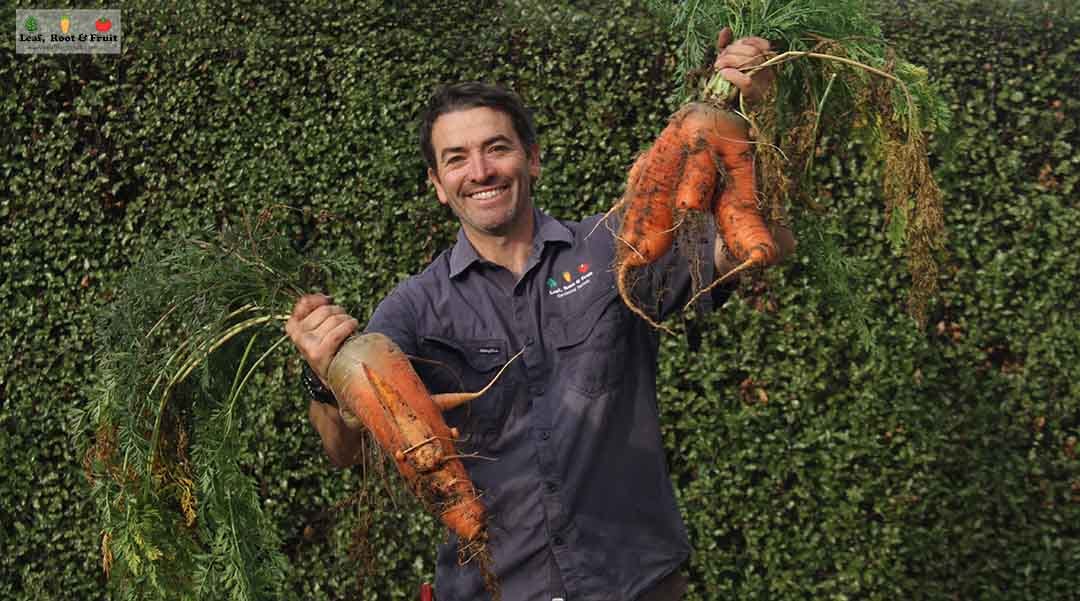I know, my Philosophy of Edible Gardening traffic light system says you should focus on growing leafy greens. But gosh, it’s so easy to become self sufficient in growing carrots. Carrots are an incredibly productive crop yielding many kilos of delicious roots per square metre. Bar a slight hiccup with long-term storage of carrots one year, my family has been self-sufficient in carrots for four years and I’ve dedicated only one raised garden bed each year to achieving this. You should definitely be growing your own carrots. There’s such joy in heading to the patch to pluck a fresh carrot for dinner. It’s one of my kids’ favourite gardening activities, even though it results in carrot roulette.
A nervous game of carrot roulette
Growing a perfect carrot is tricky, and there are plenty of pitfalls for novice gardeners to overcome. Despite my awareness of many of these pitfalls, every year I end up growing some wonky carrots. Some years there are more of them than others. This creates a game of carrot roulette.
Most of the carrots that I grow are like the two on the left in the picture above. Large, straight and pretty much perfect. However, every now and then I find one that’s forked, twisted, sometimes stumpy and anything but perfect. Just like my friend there on the right. Yes, it’s still edible. Yes, it’s still delicious. But gosh, it takes a lot more work to get it to the table.
You want to make sure you scrub your carrots to remove all soil. This is the case for all root vegetables to reduce the potential for heavy metals and other contaminants in your food. There are so many nooks and crannies with forked carrots like the one on the right. Plus, there’s a lot more surface area to clean. No one wants the job of cleaning Old Mate on the right.
The worst part is that from the soil surface there’s no way to tell which carrots are perfect and which are forked. It’s pot luck.
Common problems when growing carrots
Forked carrots can occur for a few different reasons:
Soil that is hard and or full of pebbles or rocks can cause it (which is not the case with our sandy soil).
Transplanting carrot seedlings usually results in damage to their tap root, and this leads to forked or twisted carrots. (This is number one on my list of mistakes that I see gardeners make).
In our garden, it is more likely the result of root knot nematodes or some other root munching soil critter. These may have affected the tip of the tap root while the seedling was still small, causing it to fork and develop a funky growth habit. Crop rotation and growing a biofumigant green manure crop such as mustard can help to reduce the nematode population. Read more about nematodes here.

Another problem with growing carrots is poor germination. As mentioned above, carrot seed needs to be sown directly to prevent damage to the taproot. Germination of carrot seed can take three to four weeks in cool soil. It needs to be kept moist during that whole time. If the seed bed surface dries out even for just a few hours then much of the seed is likely to fail. Keeping it moist may require you to water several times per day in warm weather. I discuss other strategies for starting carrot seed here.

Carrots are supposed to be biennial; that is, they are supposed to flower only at the end of the second growing season. I find the best way to prevent carrots from bolting is to harvest the roots before flowering occurs. I usually harvest mine in late June and pack them down for long term storage. More on that here.
The following posts in the Vegetable Patch from Scratch series will give you more information on:
Myth-busting: night vision
As children, we’re often told that eating carrots will help us to see better at night. Carrots are high in vitamin A, which is important for good vision. If someone suffers from a vitamin A deficiency, this may cause night blindness. However, carrots are not the only source of vitamin A, and provided you eat a balanced diet, chances are that eating carrots will make little difference to your night vision. This myth, at best, is only partly true.
The nitty-gritty of growing carrots: phenology, varieties and planting
Timing
This chart shows the best times to grow carrots based on my experience of growing these crops in both Melbourne (warm temperate) and Kyneton (cool temperate), both in south-eastern Australia. The timing is applicable for growers in the same climates across the southern hemisphere. Northern hemisphere folks will need to adjust the timing by six months.



